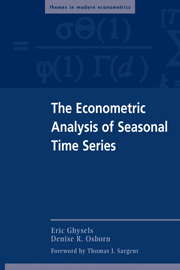Book contents
- Frontmatter
- Contents
- Foreword by Thomas J. Sargent
- Preface
- List of Symbols and Notations
- 1 Introduction to Seasonal Processes
- 2 Deterministic Seasonality
- 3 Seasonal Unit Root Processes
- 4 Seasonal Adjustment Programs
- 5 Estimation and Hypothesis Testing with Unfiltered and Filtered Data
- 6 Periodic Processes
- 7 Some Nonlinear Seasonal Models
- Epilogue
- Bibliography
- Subject Index
- Author Index
Foreword by Thomas J. Sargent
Published online by Cambridge University Press: 05 June 2012
- Frontmatter
- Contents
- Foreword by Thomas J. Sargent
- Preface
- List of Symbols and Notations
- 1 Introduction to Seasonal Processes
- 2 Deterministic Seasonality
- 3 Seasonal Unit Root Processes
- 4 Seasonal Adjustment Programs
- 5 Estimation and Hypothesis Testing with Unfiltered and Filtered Data
- 6 Periodic Processes
- 7 Some Nonlinear Seasonal Models
- Epilogue
- Bibliography
- Subject Index
- Author Index
Summary
Seasonality means special annual dependence. Many weekly, monthly, or quarterly economic time series exhibit seasonality. Eric Ghysels and Denise Osborn's book is about specifying, econometrically testing, and distinguishing alternative forms of seasonality. This subject is of high interest to economists who use dynamic economic models to understand economic time series.
Dynamic economic theory seeks to describe and interpret economic time series in terms of the purposes and constraints of economic decision makers. Economic decision makers forecast the future to inform their decisions. Dynamic theory focuses on the relationship between forecasts and decisions, a relationship characterized by the Bellman equation of dynamic programming.
From the point of view of economic theory, the seasonal dependence of economic time series is especially interesting because substantial components of seasonal fluctuations are predictable. But in the most plausible models – those of indeterministic seasonality – seasonal fluctuations are not perfectly predictable. Optimizing behavior of decision makers combined with the predictability of seasonal time series leads to sharp, cross-equation restrictions between decision makers' rules and the seasonal time series whose forecasts impinge on their decisions. Particular statistical models of seasonality of the varieties described by Ghysels and Osborn differ in the detailed statistical structure of a time series of interest to a decision maker, and so they deliver different restrictions on decision makers' behavior and so on market prices and quantities.
- Type
- Chapter
- Information
- The Econometric Analysis of Seasonal Time Series , pp. xiii - xivPublisher: Cambridge University PressPrint publication year: 2001



